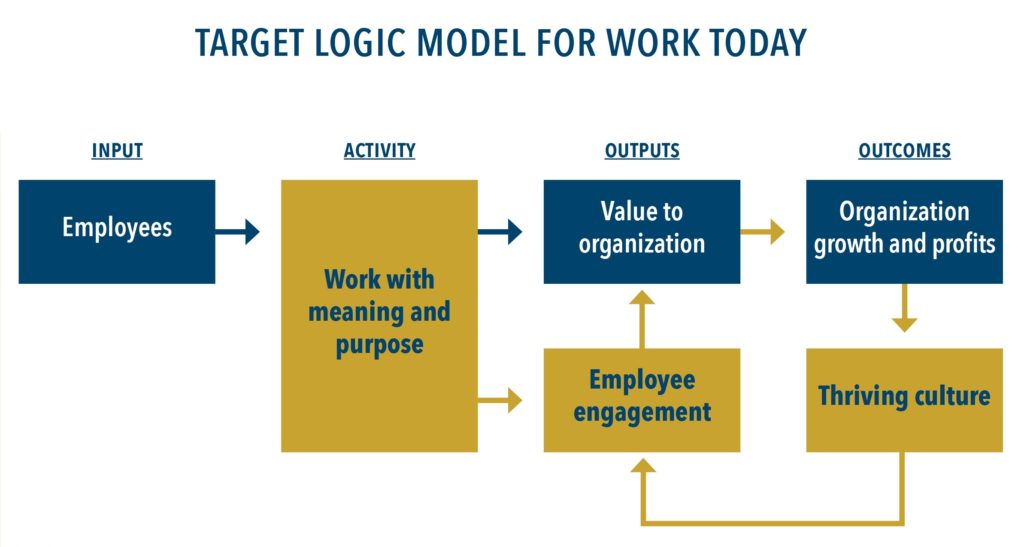Employee Engagement is Not a Thing… for Employees
Employee Engagement is Not a Thing… for Employees
Employee engagement is the subject of much buzz and attention today – and for good reason – it is a powerful determinant to an organization’s success.
Unfortunately, most often leaders and organizations take the wrong approach to employee engagement. Most organizations treat engagement as a “thing.” Ironically, it is a “thing” for organizations, but it is not a thing for employees – it is both a mindset and a state of being. As a result, there is a fundamental disconnect between engagement in the eyes of organizations and those of employees.
“Employee Engagement for employees is both a mindset and a state of being.”
-Peter C. Atherton
Employee engagement is not about the organization or its leaders.
Employee engagement is not even simply about the work and the work environment. Employee engagement pertains to how the work and the work environment supports, encourages, and enables the interests and passions of an employee. For organizations to have employee engagement, they need to create “engagement for employees.” Employee engagement is about investing. The good news is that there is a high return on investment for organizations when “it” is done well.
Let’s take a look at Engagement from two different perspectives:
Engagement for Organizations: Employee engagement is essential for organizational success, especially those employing professionals. Employee engagement is most often the catalyst for improvements in quality and performance that lead the way to greater growth and profits. These improvements increase the value delivered through successful projects and cases, treated patients, educated students, and sold products. It is also employee engagement that helps create cultures that can attract, retain, grow, and further engage.

In the target model, employees are fundamentally considered assets, and the work and the work environment (i.e., the work activities) are designed to engage and invest in those assets. The result is a new flow within an organization that works to reinforce positive outputs and outcomes.
Employee engagement is the key output to achieving this positive and reinforcing flow. The key to employee engagement, however, is work with meaning and purpose.
“The key to employee engagement is work with meaning and purpose.”
-Peter C. Atherton
An organization can contribute to this with an attractive mission, vision, and values statement… but it also needs to deliver. If the realities of the office don’t resemble the promises, or, if for one reason or another, these are not lived by or lived by consistently, there won’t be a desirable work environment and there won’t be successful employee engagement. In terms of engagement that works; “If you’re going to talk the talk, you’ve got to walk the walk.”
For most organizations to achieve the type of engagement that can create the positive and reinforcing flow, they will need to have several elements in place:
1
First, they will need a strong and attractive mission, vision, and values statement;
2
second, they will need to live by it, even if that means redesigning the workplace;
3
and third, they will need to go deeper to better understand their employees.
This brings us to the other perspective:
Engagement for Employees: For employees, engagement at work is both a state of mind and being that is influenced by the realities we face in work and life.
This is where organizations need to advance the most in terms of engagement. Top organizations better understand, look to improve, and then leverage the realities of their employees toward work with greater meaning and purpose for them.
One of the realities is that, as we progress in life, our interests and passions change and evolve – especially as we enter new work and life seasons… and what we find meaningful and purposeful also changes and evolves.
Individually, our ability to see and understand these changes is determinant to both our engagement at the office and our contentedness in life.
Organizationally, our “employee-awareness” will determine our ability to adapt to both accommodate the changes in interests and passions to encourage engagement as well as the organization’s ability to leverage and grow through these changes.
For example, during the early portions of our adult life, excelling to master our craft, make a name, and provide for ourselves and our families is both an interest and a passion for most high-achieving professionals and business owners. Excelling in this context is also something we likely found purpose in. But… life, families, circumstances, and perspectives change.
As top performers enter new seasons, all parties must adapt if we want to stay and grow together. Very few top performers will want to do at 50 what they were willing to do at 30. At the same time, experienced top performers can leverage more value in the same or less time than other less experienced talent – which is why it is so important for organizations to work to engage and retain this talent. This doesn’t exactly mean experienced talent wants to work less, although they may need a break… but it does mean that organizations need to keep up.
The reality is that all top performers want to continually grow – both personally and professionally. At work, this can mean expanded or new roles, as well as, expanded relationships and new experiences. If we don’t adapt, feelings of discontent take hold which ultimately lead to disengagement, feeling trapped, or a desire to pivot away to something new.
Top organizations anticipate employee changes and offer adaptive win-win models that will encourage engagement as well as boost loyalty, goodwill, and performance.
“Organizations that are willing and able to support, encourage, and enable employees to win at both work and life open up channels for engagement.”
-Peter C. Atherton
The presence of burnout and disengagement, of course, changes everything. Before the benefit of any of the above can be realized, burnout needs to be reversed which I provide a blueprint for in my book, Reversing Burnout. How to Immediately Engage Top Talent and Grow!
For more related to employee engagement, check out our other blog series:
To your winning,

PS – Ready to increase your engagement and your impact? Check out our Fast Start Programs.
PSS – I invite you to schedule a free, no-obligation 30-minute conversation HERE. We will walk through the I.M.P.A.C.T. process for organizations and I guarantee you will leave the call with a few new ideas and a clearer vision.

Pete Atherton
About the Author
Peter C. Atherton, P.E. is an AEC industry insider with over 30 years of experience, having spent more than 24 as a successful professional civil engineer, principal, major owner, and member of the board of directors for high-achieving firms. Pete is now the President and Founder of ActionsProve, LLC, author of “Reversing Burnout. How to Immediately Engage Top Talent and Grow! A Blueprint for Professionals and Business Owners”, and the creator of the I.M.P.A.C.T. process.
Pete is also the host of The AEC Leadership Today Podcast and leads The AEC Leadership Mastermind.
Pete works with AEC firms to grow and advance their success through modern and new era focused strategic planning, executive coaching, leadership and management team development, performance-based employee engagement, and corporate impact design. Connect with him through the contact link below.


